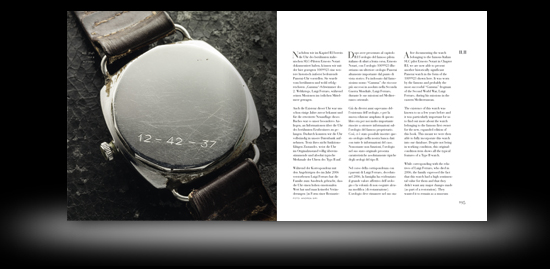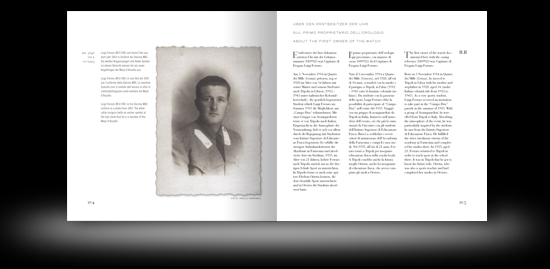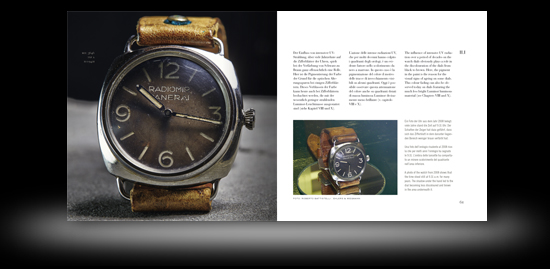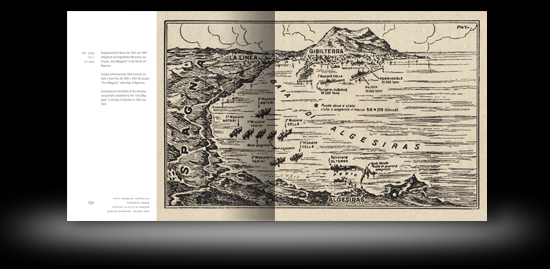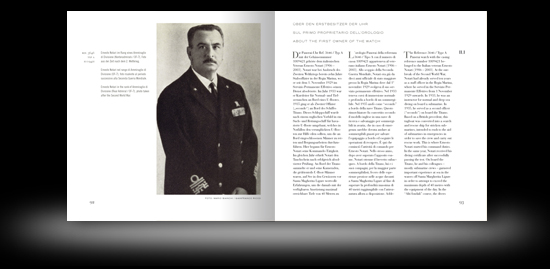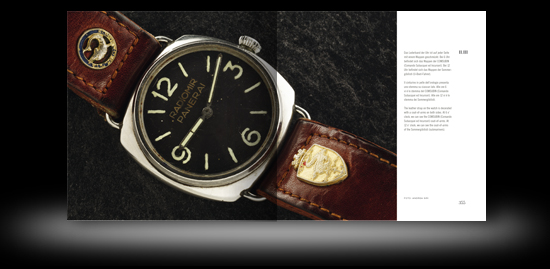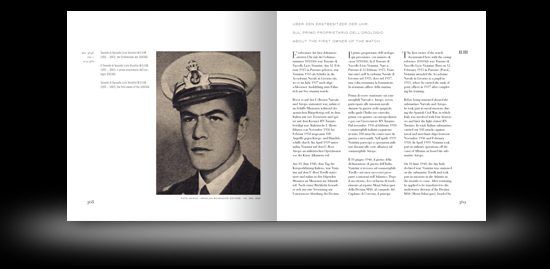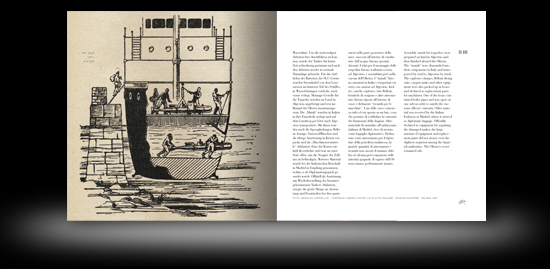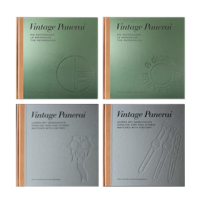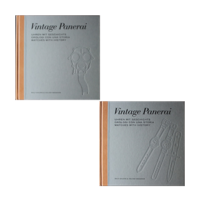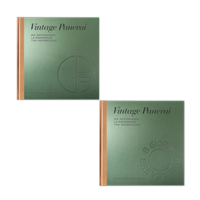Naval heritage – Luigi Ferraro’s Radiomir
by Volker on Jul.10, 2025, under Allgemein
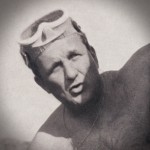 Without a doubt, Luigi Ferraro was a man whose entire life was shaped by the sea. As a talented swimmer, he had been fascinated by the element of water since his youth. During the Second World War, he became one of the best-known frogmen of all time and showed great courage and skill during his dangerous missions, taking himself into the very limits both physically and mentally.
Without a doubt, Luigi Ferraro was a man whose entire life was shaped by the sea. As a talented swimmer, he had been fascinated by the element of water since his youth. During the Second World War, he became one of the best-known frogmen of all time and showed great courage and skill during his dangerous missions, taking himself into the very limits both physically and mentally.
His Radiomir watch, a Ref. 3646 / Type B with riveted plastic dial, has been with him since he was a “Gamma” frogman in the Second World War. With the kind support of his family we were able to document his watch in chapter II.II of our book “The References” together with a view onto his life – before, during and after the war.
Page 194 – 195: View on the engraved caseback of Luigi Ferraro’s 3646 / Type B.
In January 1943, Luigi Ferraro obtained his qualification to carry out underwater missions. He was first posted to North Africa, where he was to attack ships from the British armed forces in the Port of Tripoli. Before the attack could take place, he was ordered back to Italy. Soon later he became an instructor for “Gamma” frogmen of the Mezzi d’Assalto. In May 1943, he was posted to La Spezia and received instructions from Junio Valerio Borghese for a new mission – this time, in the eastern Mediterranean.
Page 204 – 205: About the first owner of the watch. Luigi Ferraro in uniform, photo dated to 1943. The white collar insignia (with an anchor symbol at the top) show that he is a member of the Mezzi d’Assalto.
Luigi Ferraro carried out four missions during July and August 1943 in the Turkish ports of Alexandretta and Mersina. These four missions resulted in the sinking of two ships and the deactivation of a third. Undiscovered and highly successful, the “Operazione Stella” was one of the most effective operations of the Mezzi d’Assalto. Luigi Ferraro was awarded with the M.O.V.M. (gold medal for galantry at war) in the rank of Tenente Artiglieria.
Page 210 – 211: Sketch of two of the four “Stella” missions carried out by Luigi Ferraro in Alexandretta.
After his time as a “Gamma” frogman, he used the skills and abilities he had learnt in the war for civilian purposes. He was able to pass on his extensive knowledge and significant experience to countless divers. Luigi Ferraro was promoted by the Marina Militare to Capitano di Fregata di Complemento in the year 2000.
The watch of Luigi Ferraro (1914 – 2006) and the history behind can be read in the book “The References” 1930’s-1940’s (chapter II.II, page 190 to 225). Read more on “Operazione Stella” here. Enjoy reading!
Visintini’s 3646 / Type C “Radiomir Panerai”
by Volker on Jul.03, 2025, under Allgemein
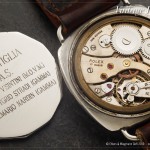 A watch of the Reference 3646 / Type C which belonged to the SLC pilot Licio Visintini is featured in chapter II.III. Visintini took part in several missions against the allied fleet in Gibraltar.
A watch of the Reference 3646 / Type C which belonged to the SLC pilot Licio Visintini is featured in chapter II.III. Visintini took part in several missions against the allied fleet in Gibraltar.
After surviving from mission B.G.3 and B.G.4 in 1941, Visintini returned undercover to Gibraltar in June 1942 where he built the core of the “Orsa Maggiore” on board the tanker Olterra – the hidden base for the SLC units of the “Decima” in the bay of Gibraltar. Mission B.G.5 turned into a “mission with no return” for Licio Visintini in December 1942…
The documentation of the watch (engraved caseback and view into the movement shown above) and the history of Licio Visintini can be read from page 350 to 397 in chapter II.III.
Information on “The References” 1930’s-1940’s (first volume) can be found here.
Naval heritage – Ernesto Notari’s Radiomir
by Volker on Jun.20, 2025, under Allgemein
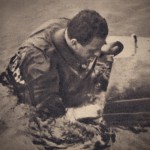 Since 1992, the Vintage Panerai watch which was worn by SLC pilot Ernesto Notari during the Second World War, is on display at the Museo Tecnico Navale in La Spezia. Back then, the watch’s first owner decided to give the watch to the museum on his own wish. It was accepted into the museum’s inventory and since then, it has been on display in a cabinet with other rare items from the Mezzi d’Assalto, where it is resting on one of the last remaining SLC devices.
Since 1992, the Vintage Panerai watch which was worn by SLC pilot Ernesto Notari during the Second World War, is on display at the Museo Tecnico Navale in La Spezia. Back then, the watch’s first owner decided to give the watch to the museum on his own wish. It was accepted into the museum’s inventory and since then, it has been on display in a cabinet with other rare items from the Mezzi d’Assalto, where it is resting on one of the last remaining SLC devices.
In its unaltered original condition, it was an important source of information for us. With the support of the museum we were able to enter all details of the watch into our database. Beside the importance by the history behind, this watch marks the earliest known 3646 / Type A and so became the first watch in chapter II. With its engraved caseback it is of enormous significance with regard to the history of the Mezzi d’Assalto of the Royal Italian Navy.
Page 60 – 61: Comparing photos of Ernesto Notari’s Ref. 3646 / Type A from 2014 and 2008.
Being a member of the Mezzi Subacquei, Ernesto Notari trained at Bocca di Serchio, the secret base of the underwater special unit in Tuscany. In early 1940, the first training exercises were carried out, resulting in the 1935 concept of Teseo Tesei and Elios Toschi evolving into a real, secret weapon. After the desaster of Malta in July 1941, Ernesto Notari was commander of the training base Bocca di Serchio.
In 1943 Notari posted to the secret base in the Bay of Algeciras, the Olterra. After the successful return from mission B.G.6 in May 1943, Notari was awarded with the M.A.V.M. (silver medal for galantry at war) in the rank of Capitano di Corvetta. He solved another successful mission in August 1943: B.G.7, for which he was awarded M.A.V.M. one more time. B.G.7 was the last mission carried out from the tanker Olterra. The declaration of the ceasefire by Italy on 8 September 1943 brought all further plans to an end. The secret of the Olterra was only discovered by the British in October 1943. The undercover missions of the Decima MAS in Gibraltar were therefore highly successful. Although they did not have any major successes like in Alexandria, the continued presence of the Decima for a period of almost three years exercised constant pressure on the British. The use of Villa Carmela and the Olterra as secret starting bases for night-time missions showed the decisiveness of the Decima MAS and its courageous men – one of whom was Ernesto Notari.
Page 150 – 151: Illustration of the missions completed by the “Orsa Maggiore” in the Bay of Algeciras in 1942 and 1943.
After the Second World War, Ernesto Notari continued his career with the Marina Militare. As a Capitano di Fregata, he commanded the reformed special unit from 10 October 1947 to 25 September 1948. As a Capitano di Vascello, Notari served his second captaincy from 1 October 1950 to 14 March 1951. In 1952, he assumed command of the Sezione Tecnica Autonoma in Bacoli. The secret base in the province of Naples existed from 1949 to 1957 before being moved to Varignano as part of a restructuring process . This site was home to some of the remaining Mezzi d’Assalto equipment. By the end of his Navy career, Ernesto Notari had reached the rank of Vice-Admiral (Ammiraglio di Squadra).
Page 92 – 93: About the first owner of the watch, Admiral Ernesto Notari, photo taken after the Second World War.
The watch of Ernesto Notari (a Ref. 3646 / Type A with „Radiomir Panerai“ dial) and the history behind can be read in the book “The References” 1930’s-1940’s (chapter II.I, page 58 to 153). Read more on the Olterra here. Enjoy reading!
Naval heritage – Licio Visintini’s Radiomir
by Volker on Jun.15, 2025, under Allgemein
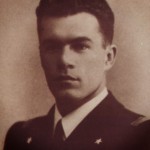 SLC pilot Tenente di Vascello Licio Visintini M.O.V.M. took part on several missions against the allied fleet in Gibraltar as a member of the Mezzi d’Assalto.
SLC pilot Tenente di Vascello Licio Visintini M.O.V.M. took part on several missions against the allied fleet in Gibraltar as a member of the Mezzi d’Assalto.
After returning from the SLC missions B.G.3, being pilot of SLC 160 in May 1941 and B.G.4, being pilot of SLC 220 in September 1941 (both carried out from the transport submersible “Scirè” under the command of Junio Valerio Borghese), Licio Visintini, twice awarded with the silver medal for galantry at war (M.A.V.M.), returned to Gibraltar undercover in June 1942. He built the core of the “Orsa Maggiore” on board the tanker Olterra – the new, hidden base for the SLC units in the bay of Gibraltar (which remained undiscovered until September 1943). Read more on the Olterra here.
After months of preparations and training in complete secrecy, the SLC mission B.G.5 took progress in December 1942 with three SLC devices of the 200-series: 228, 229 and 236. For Licio Visintini, Giovanni Magro and Salvatore Leone it was a missions with no return. Read the complete story about their fateful SLC mission and how Licio Visintini’s Ref. 3646 / Type C with “Radiomir Panerai” dial returned to Italy and changed ownership two times after, on page 368-397.
Page 354 – 355: Licio Visintini’s 3646 / Type C. The strap has been decorated with coat-of-arms of the Sommergibilisti (submariners) and COMSUBIN (Raggruppamento subacquei e incursori “Teseo Tesei”). The Rolex movement of the watch has been introduced here.
Page 368 – 369: About the first owner of the watch. Tenente di Vascello Licio Visintini M.O.V.M.
Page 386 – 387: Illustration of the secret SLC base Olterra at the pier in Algeciras / Bay of Gibraltar.
The watch of Tenente di Vascello Licio Visintini (1915 – 1942) and the history behind can be read in the book “The References” 1930’s-1940’s (chapter II.III, page 350 to 397). Read more on Licio Visintini here. Enjoy reading!
A look into our book “The References” 1930’s-1940’s
by Volker on May.25, 2025, under Allgemein
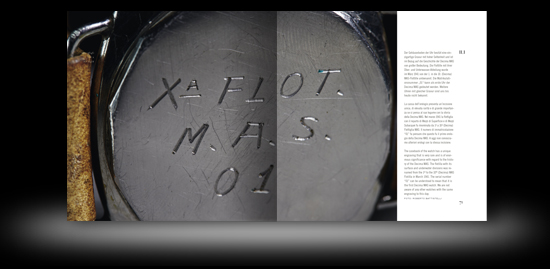
Page 70-71 – engraved caseback of a Ref. 3646 / Type A “Radiomir Panerai”.
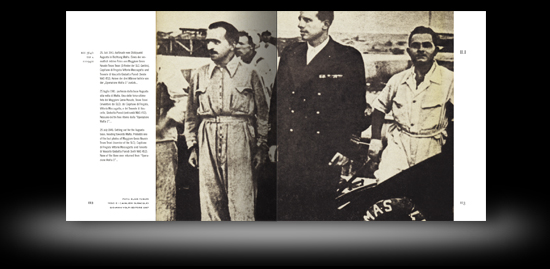
Page 112-113 – 25 July 1941: „Operazione Malta 1“ – setting out for the Augusta base, heading towards Malta: Teseo Tesei (SLC), Vittorio Moccagatta and Giobatta Parodi (MAS 452).
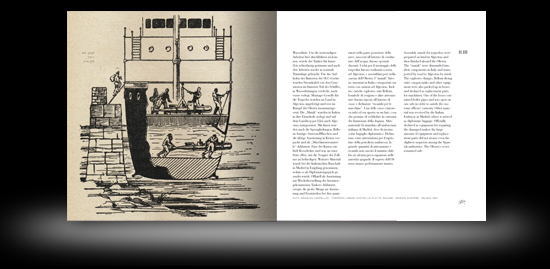
Page 358-359 – contemporary illustration of SLC missions starting from the “Olterra” in the Bay of Gibraltar (1942 and 1943).
 “The References” 1930’s-1940’s at a glance:
“The References” 1930’s-1940’s at a glance:
33 Vintage Panerai watches, history, instruments and straps of the 1930’s-1940’s. Featured References: 2533, 3646, the Mare Nostrum chronograph and compasses.
26 x 26 cm, 696 pages, trilingual (German, Italian and English language in one book), 19 database charts, 383 illustrations, including rare historic photos from the 2nd World War, hardback jacket, slipcase.
Visit our bookstore and enjoy reading soon!
A look into our book “The References” 1950’s-1960’s
by Volker on May.17, 2025, under Allgemein
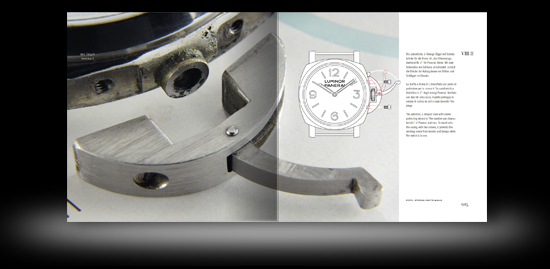
Page 924-925 – the patented, L-shaped lever with crown-protecting device of a Ref. 6152/1.
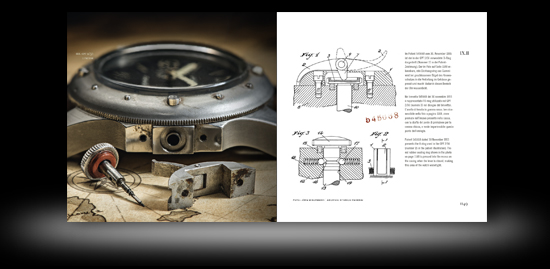
Page 1148-1149 – patent 545668 (dated 30 November 1955) presents the O-ring used in the GPF 2/56.
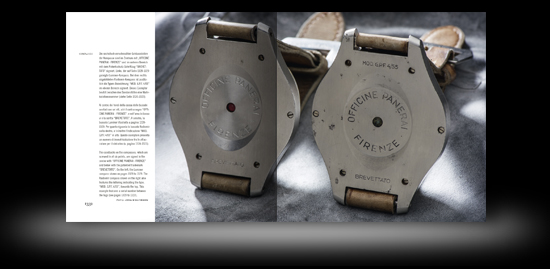
Page 1332-1333 – the casebacks on the compasses, which are screwed in at six points, ar signed in the center with „OFFICINE PANERAI – FIRENZE“ and below with the patented trademark „BREVETTATO“. The Radiomir compass on the right also features the „MOD. G.PF. 4/55“.
 “The References” 1950’s-1960’s at a glance:
“The References” 1950’s-1960’s at a glance:
37 Vintage Panerai watches from the 1950’s to 1960’s. Featured References: 6152, 6154, 6152/1, GPF 2/56 and modified References, compasses and depth gauges followed by an overview of the straps and buckles used in this era.
26 x 26 cm, 696 pages, trilingual (German, Italian and English language in one book), 27 database charts, 353 illustrations, including rare historic photos from Italian and Egyptian frogmen, hardback jacket, slipcase.
Visit our bookstore and enjoy reading soon!
Restart after the end of the Second World War
by Volker on May.09, 2025, under Allgemein
What brought about the demand for new and improved diver’s watches in Italy after the end of the Second World War? The answer to this question is inextricably intertwined with the history of the maritime special units, whose transformation from the Mezzi d’Assalto of the Decima MAS to the COMSUBIN took many years.
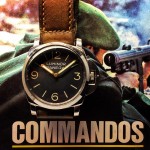 From 1947 to 1951, various divisions and bases were established, restructured and merged, finally settling on COMSUBIN (Comando Subacquei ed Incursori) in 1961. Varignano near La Spezia, headquarters of the COMSUBIN and, as of 1952, was and still is the base for the Scuola Incursori. One of the instructors in the 1950’s was Emilio Barberi M.O.V.M., shown on page 716 (MT explosive boat veteran of the mission against Souda Bay, March 1941, see also page 108-109 in chapter II.I). Read more in the intro of “The References” 1950’s-1960’s on page 705-719. These maritime special units were set up during the same period that Guido Panerai & Figlio was producing watches with the References 6152, 6154, 6152/1 and GPF 2/56, which are documented in chronological order in chapters VI to X. Compasses and depht gauges from these years are following in chapter XI, straps and buckles are closing this second volume of “The References” in chapter XII. Find an overview of all chapters in this book below:
From 1947 to 1951, various divisions and bases were established, restructured and merged, finally settling on COMSUBIN (Comando Subacquei ed Incursori) in 1961. Varignano near La Spezia, headquarters of the COMSUBIN and, as of 1952, was and still is the base for the Scuola Incursori. One of the instructors in the 1950’s was Emilio Barberi M.O.V.M., shown on page 716 (MT explosive boat veteran of the mission against Souda Bay, March 1941, see also page 108-109 in chapter II.I). Read more in the intro of “The References” 1950’s-1960’s on page 705-719. These maritime special units were set up during the same period that Guido Panerai & Figlio was producing watches with the References 6152, 6154, 6152/1 and GPF 2/56, which are documented in chronological order in chapters VI to X. Compasses and depht gauges from these years are following in chapter XI, straps and buckles are closing this second volume of “The References” in chapter XII. Find an overview of all chapters in this book below:
Chapter VI = Reference 6152
(featuring three different watches on page 720-781)
Chapter VII = Reference 6154
(featuring five different watches on page 782-867)
Chapter VIII = Reference 6152/1 with Rolex movements
(featuring fourteen different watches on page 868-1057)
Chapter IX = GPF 2/56
(featuring five different watches on page 1058-1161)
Chapter X = Modified References with Angelus movements
(featuring ten different watches on page 1162-1313)
Chapter XI = Compasses and depth gauges
(featuring fifteen different instruments on page 1314-1367)
Chapter XII = Straps and buckles
(various straps and pin buckles on page 1368-1387)
“The References” books are in stock and ready for shipping – just visit our bookstore and enjoy reading! [Ralf Ehlers & Volker Wiegmann]
Missions of the Egypt frogmen
by Volker on May.07, 2025, under Allgemein
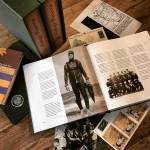 The Red Sea, the Straits of Tiran, the Gulf of Aqaba, even the shores of Dakar (Senegal) and Abidjan (Ivory Coast) – target zones of the Egypt frogmen during the Suez Crisis, the Six-Day War and the Yom Kippur War.
The Red Sea, the Straits of Tiran, the Gulf of Aqaba, even the shores of Dakar (Senegal) and Abidjan (Ivory Coast) – target zones of the Egypt frogmen during the Suez Crisis, the Six-Day War and the Yom Kippur War.
Not very much has been ever published before about missions against enemy ports, ships and oil platforms during the conflicts between Egypt and Israel. In the mid-50’s, both Egyptian and Israeli special forces attended separate training courses in Italy to learn the skills for underwater missions from their Italian instructors. After our search for historical documents and with the support of a high decorated Egypt frogmen veteran we were able to put a spotlight on some of the missions carried out decades ago.
Read the historical background on watches and instruments from Guido Panerai & Figlio used by the Egypt frogmen in chapter VII and IX of “The References” 1950’s-1960’s (second volume), accompanied with rare historic photos (page 794-795 shown in the coffee table shot above). The new “The References” books (two volumes with 696 pages each) can be ordered only in our bookstore. Enjoy reading!
“Luminor Panerai” Depth Gauge
by Volker on Apr.28, 2025, under Allgemein
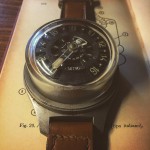 Compasses and depth gauges made by Guido Panerai & Figlio are featured in several versions (with “Radiomir” and “Luminor” luminous material) in chapter XI of the second volume of our book “The References”.
Compasses and depth gauges made by Guido Panerai & Figlio are featured in several versions (with “Radiomir” and “Luminor” luminous material) in chapter XI of the second volume of our book “The References”.
Chapter XI.I is featuring compasses from Guido Panerai & Figlio. Five different models are featured from page 1320 to 1333. Three with “Radiomir”, two with “Luminor”. Chapter XI.II is featuring depth gauges from Guido Panerai & Figlio, similiar to the instrument which can be seen in the photo. Ten different models are featured from page 1334 to 1367. Six with “Radiomir”, aimed to 7, 30, 35 (2 versions: adjustable and non-adjustable dial), 50 and 60 meters. Four with “Luminor”, aimed to 7, 15, 16, 30 and 40 meters.
Click on the link to see the video of a pressure test on a “Luminor Panerai” 16 meter depth gauge: Vintage_Panerai_Depth_Gauge. Click on the link to see the pressure release – “the surfacing” in this video: Vintage_Panerai_depth_gauge_surfacing
“Luminor Panerai” Compass
by Volker on Apr.22, 2025, under Allgemein
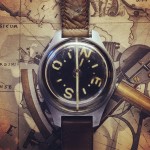 Compasses and depth gauges made by Guido Panerai & Figlio are featured in several versions (with “Radiomir” and “Luminor” luminous material) in chapter XI of the second volume of our book “The References”.
Compasses and depth gauges made by Guido Panerai & Figlio are featured in several versions (with “Radiomir” and “Luminor” luminous material) in chapter XI of the second volume of our book “The References”.
Chapter XI.I is featuring compasses from Guido Panerai & Figlio. Five different models are featured from page 1320 to 1333. Three with “Radiomir”, two with “Luminor”, similiar to the instrument which can be seen in the photo.
Our book “The References” 1950’s-1960’s is featuring several historic photos in which such compasses from Guido Panerai & Figlio can be spotted on page 794, 1064, 1068, 1316, 1318.

